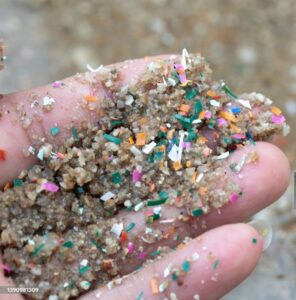Creating a Hydrogel That Removes Microplastics from Water
ENVIRONMENT, 22 Apr 2024
Pressenza - TRANSCEND Media Service

Close-up side shot of hands shows microplastic waste contaminated with the seaside sand. Microplastics are contaminated in the sea. Concept of water pollution and global warming. (Image by Pexels)
A breakthrough in the fight against pollution. Researchers at the Indian Institute of Science in India have developed a sustainable hydrogel that removes microplastics from water by binding them and breaking them down under ultraviolet light.
16 Apr 2024 – This hydrogel consists of three different polymer layers (chitosan, polyvinyl alcohol, and polyaniline) that are intertwined to form an interpenetrating polymer network architecture.
The researchers conducted several experiments in which they added a fluorescent dye to the microplastics to track how much of the hydrogel was absorbed and degraded under different conditions. To do this, the team shredded food container lids and other plastic products to create two of the most common microplastics in existence: polyvinyl chloride and polypropylene.
The experiments showed that the hydrogel was able to remove around 95 and 93 percent of the two different types of microplastics in water at near-neutral pH.
One of the biggest problems in today’s society is the widespread health-threatening plastic pollution around the world, which can enter the human body through our drinking water and cause disease, as well as the threat it poses to the global environment.
Source: Prensa Latina.
Go to Original – pressenza.com
Tags: Chemical pollution, Hydrogel, Marine pollution, Microplastics, Plastic Pollution, Pollution
DISCLAIMER: The statements, views and opinions expressed in pieces republished here are solely those of the authors and do not necessarily represent those of TMS. In accordance with title 17 U.S.C. section 107, this material is distributed without profit to those who have expressed a prior interest in receiving the included information for research and educational purposes. TMS has no affiliation whatsoever with the originator of this article nor is TMS endorsed or sponsored by the originator. “GO TO ORIGINAL” links are provided as a convenience to our readers and allow for verification of authenticity. However, as originating pages are often updated by their originating host sites, the versions posted may not match the versions our readers view when clicking the “GO TO ORIGINAL” links. This site contains copyrighted material the use of which has not always been specifically authorized by the copyright owner. We are making such material available in our efforts to advance understanding of environmental, political, human rights, economic, democracy, scientific, and social justice issues, etc. We believe this constitutes a ‘fair use’ of any such copyrighted material as provided for in section 107 of the US Copyright Law. In accordance with Title 17 U.S.C. Section 107, the material on this site is distributed without profit to those who have expressed a prior interest in receiving the included information for research and educational purposes. For more information go to: http://www.law.cornell.edu/uscode/17/107.shtml. If you wish to use copyrighted material from this site for purposes of your own that go beyond ‘fair use’, you must obtain permission from the copyright owner.
Join the discussion!
We welcome debate and dissent, but personal — ad hominem — attacks (on authors, other users or any individual), abuse and defamatory language will not be tolerated. Nor will we tolerate attempts to deliberately disrupt discussions. We aim to maintain an inviting space to focus on intelligent interactions and debates.